Abstract
To test the hypothesis that the activation of protein kinase C (PKC) is influenced by lateral heterogeneities of the components of the lipid bilayer, the thermotropic phase behavior of dimyristoylphosphatidylcholine (DMPC)/dimyristoylphosphatidylserine (DMPS)/dioleoylglycerol (DO) vesicles was compared with the activation of PKC by this system. Differential scanning calorimetry (DSC) and Fourier transform infrared (FTIR) spectroscopy were used to monitor the main transition (i.e., the gel-to-fluid phase transition) as a function of mole fraction DO (chi(DO)) in DMPC/DO, DMPS/DO, and [DMPC/DMPS (1:1, mol/mol)]/DO multilamellar vesicles (MLVs). In each case, when chi(DO) < or approximately 0.3, DO significantly broadened the main transition and shifted it to lower temperatures; but when chi(DO) > approximately 0.3, the main transition became highly cooperative, i.e., narrow, again. The coexistence of overlapping narrow and broad transitions was clearly evident in DSC thermograms from chi(DO) approximately 0.1 to chi(DO) approximately 0.3, with the more cooperative transition growing at the expense of the broader one as chi(DO) increased. FTIR spectroscopy, using analogs of DMPC and DMPS with perdeuterated acyl chains, showed that the melting profiles of all three lipid components in [DMPC/DMPS (1:1, mol/mol)]/DO MLVs virtually overlay when chi(DO) = 0.33, suggesting that a new type of phase, with a phospholipid/DO mole ratio near 2:1, is formed in this system. Collectively, the results are consistent with the coexistence of DO-poor and DO-rich domains throughout the compositions chi(DO) approximately 0.1 to chi(DO) approximately 0.3, even at temperatures above the main transition. Comparison of the phase behavior of the binary mixtures with that of the ternary mixtures suggests that DMPS/DO interactions may be more favorable than DMPC/DO interactions in the ternary system, especially in the gel state. PKC activity was measured using [DMPC/DMPS (1:1, mol/mol)]/DO MLVs as the lipid activator. At 35 degrees C (a temperature above the main transition of the lipids), PKC activity increased gradually with increasing chi(DO) from chi(DO) approximately 0.1 to chi(DO) approximately 0.4, and activity remained high at higher DO contents. In contrast, at 2 degrees C (a temperature below the main transition), PKC activity exhibited a maximum between chi(DO) approximately 0.1 and chi(DO) approximately 0.3, and at higher DO contents activity was essentially constant at 20-25% of the activity at the maximum. We infer from these results that the formation of DO-rich domains is related to PKC activation, and when the lipid is in the gel state, the coexistence of DO-poor and DO-rich phases also contributes to PKC activation.
Full text
PDF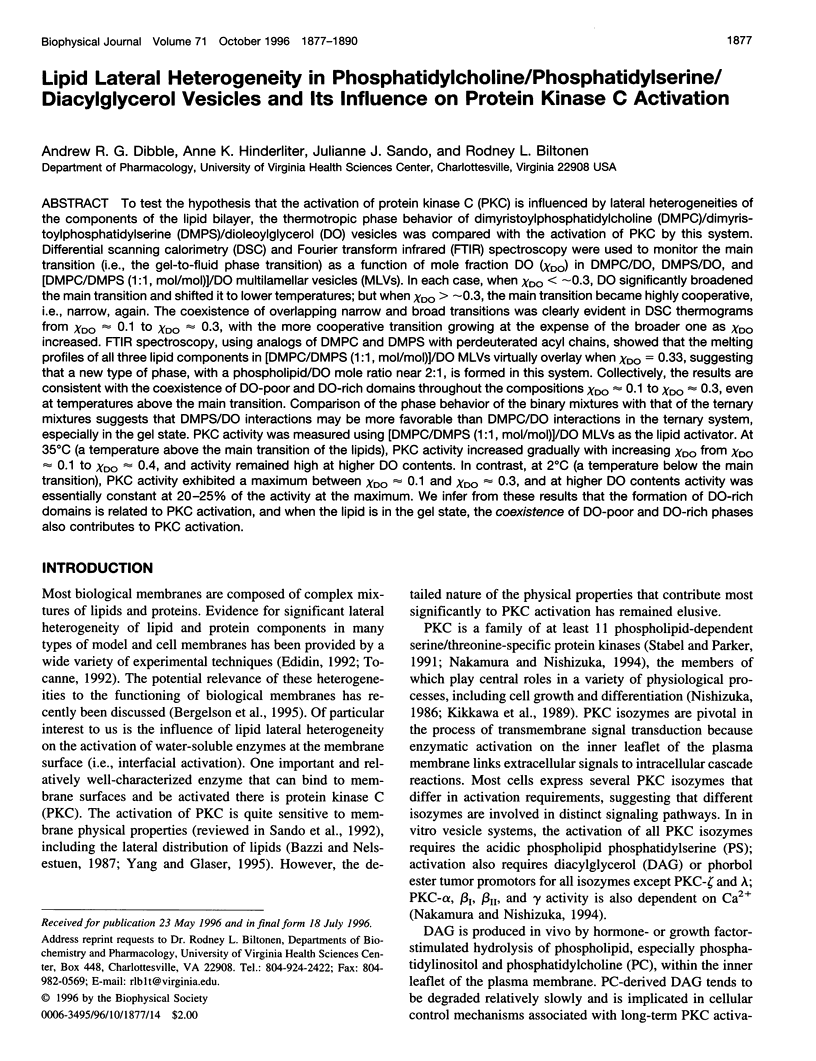
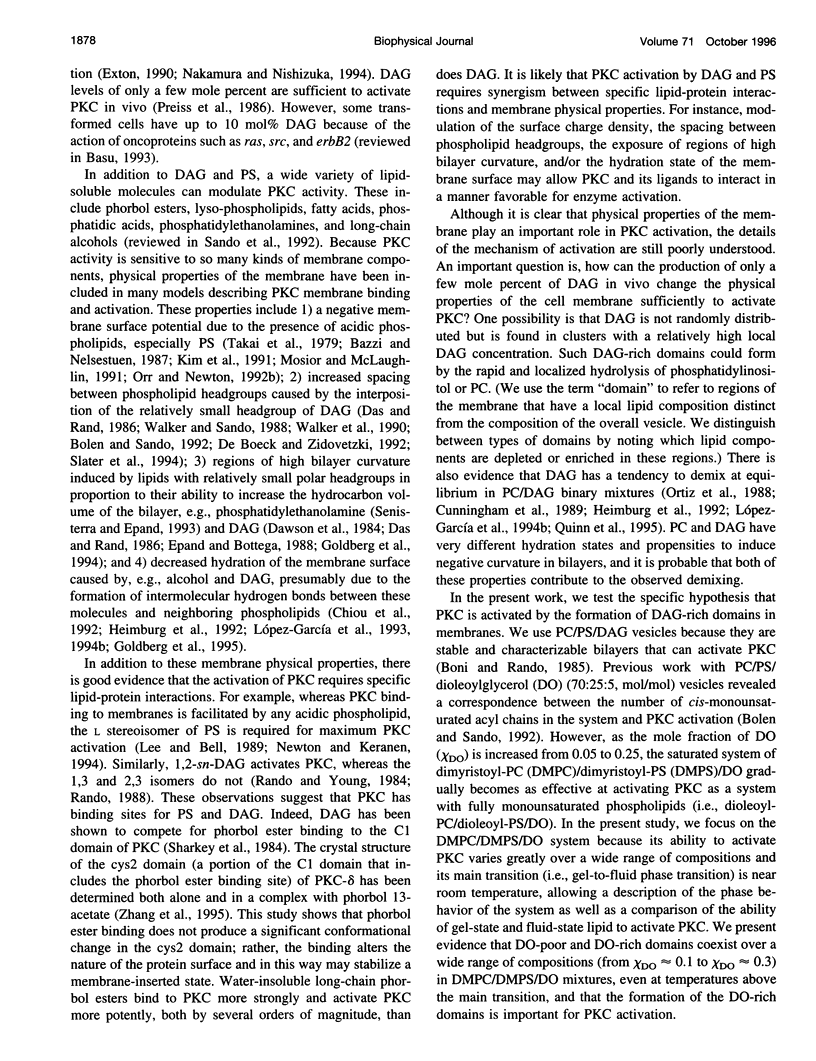

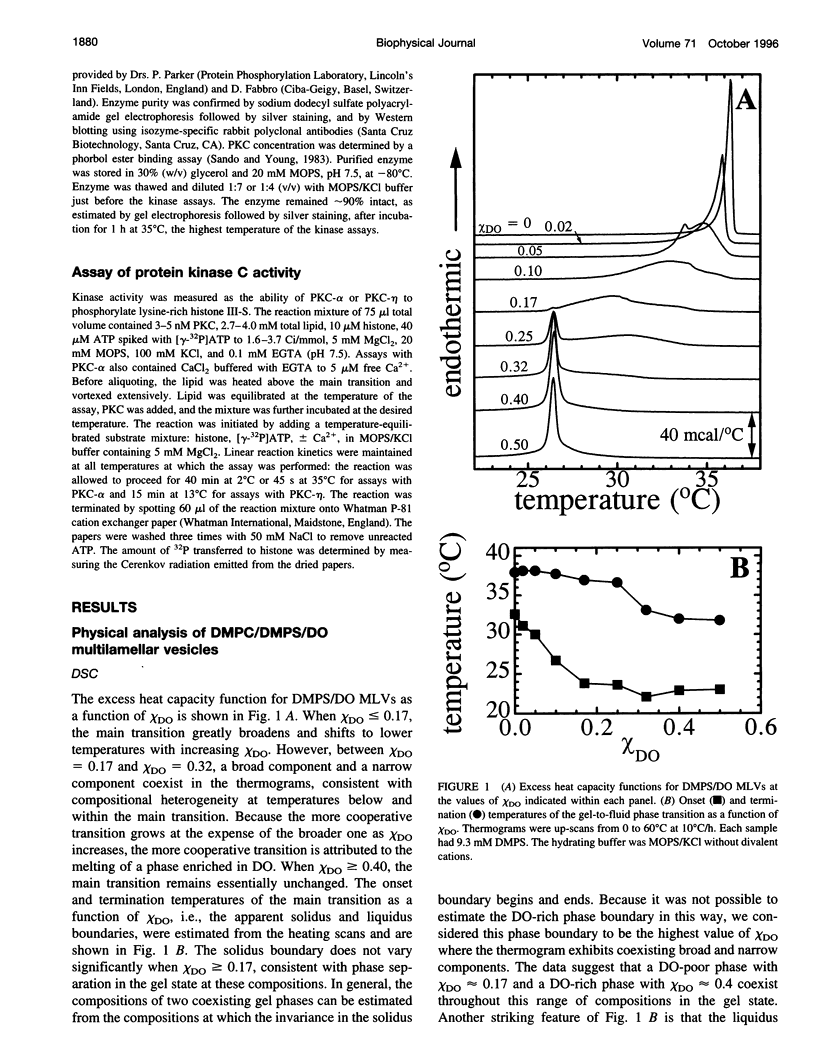

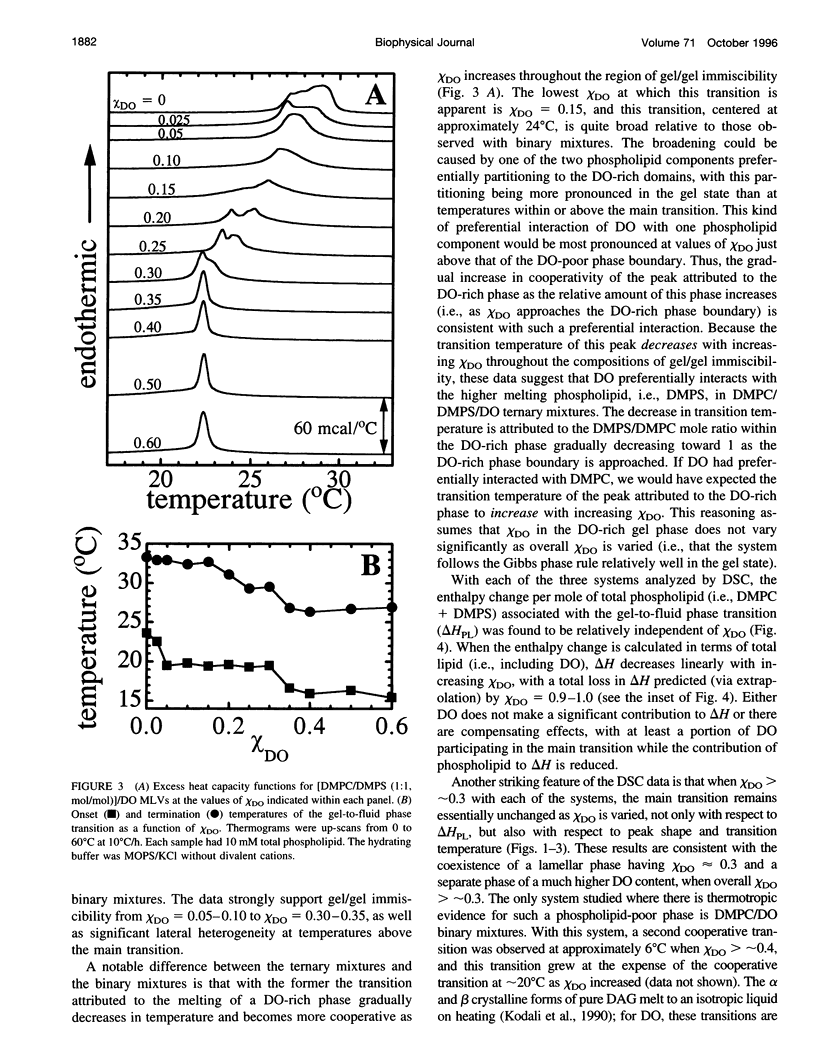



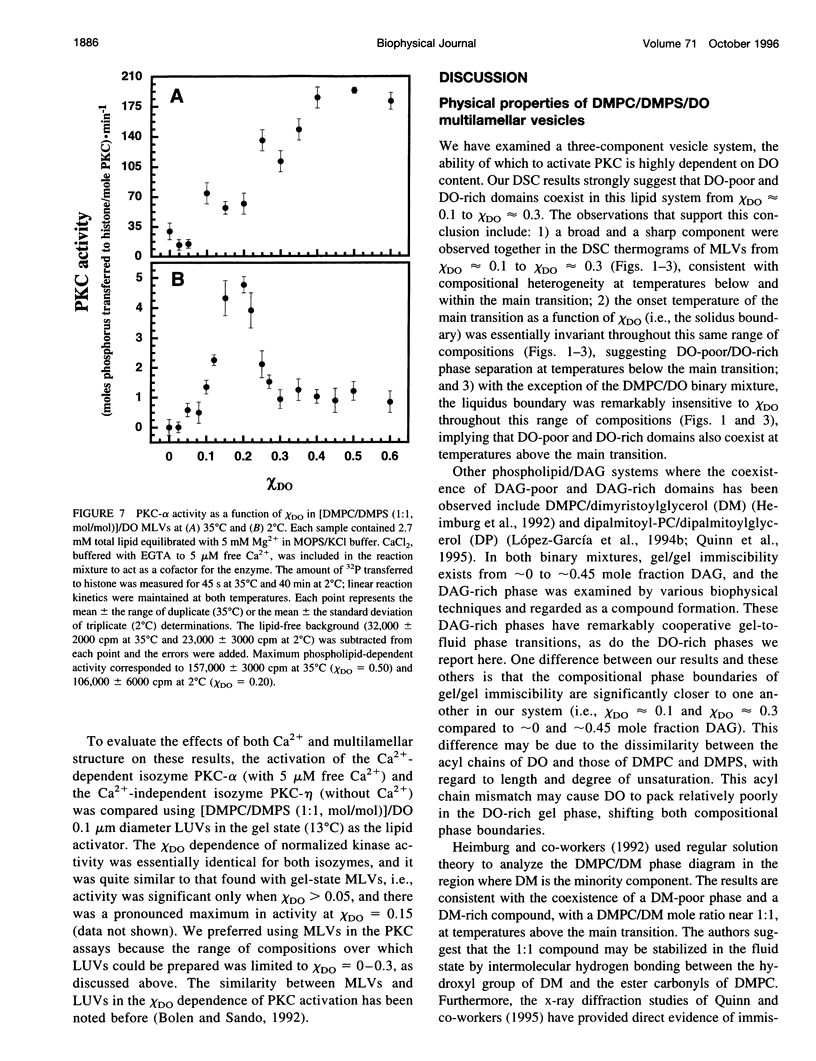

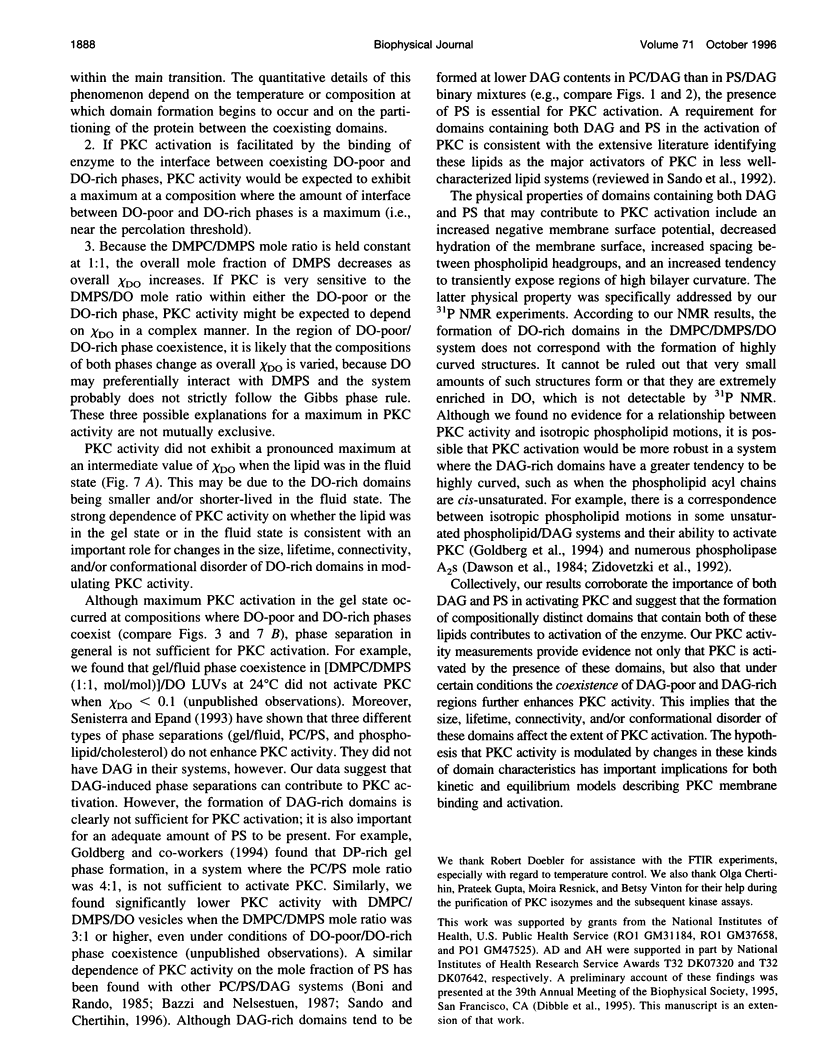
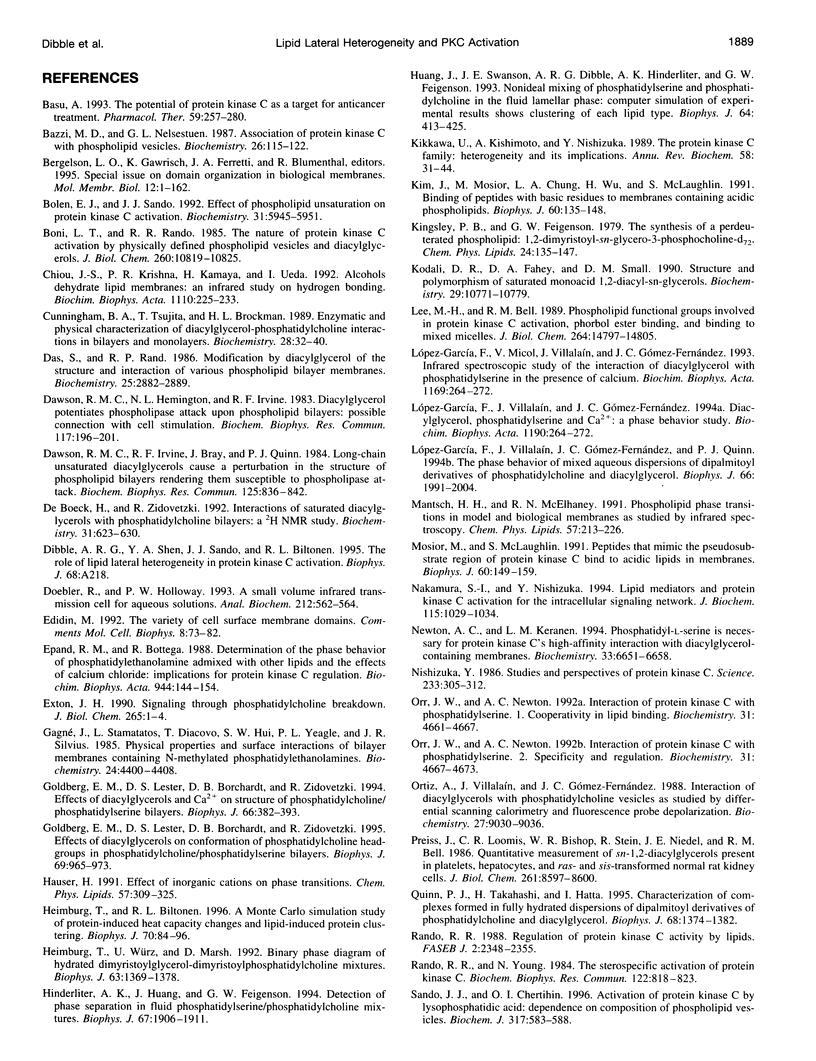
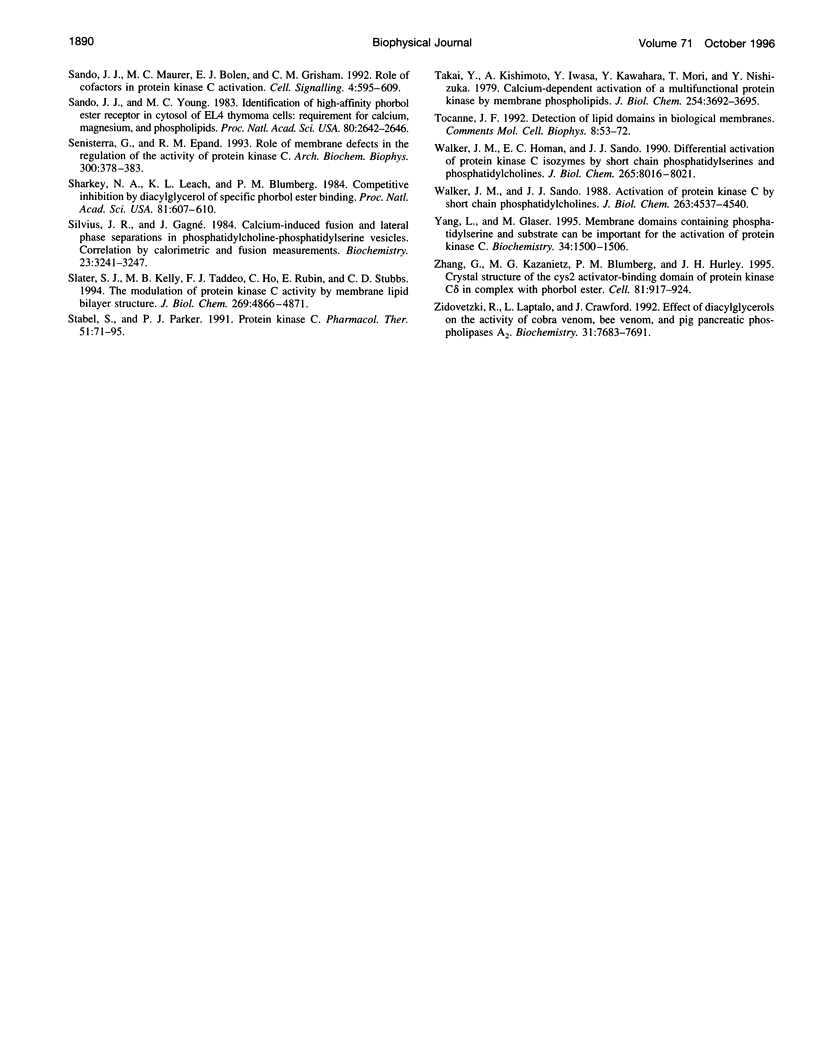
Selected References
These references are in PubMed. This may not be the complete list of references from this article.
- Basu A. The potential of protein kinase C as a target for anticancer treatment. Pharmacol Ther. 1993 Sep;59(3):257–280. doi: 10.1016/0163-7258(93)90070-t. [DOI] [PubMed] [Google Scholar]
- Bazzi M. D., Nelsestuen G. L. Association of protein kinase C with phospholipid vesicles. Biochemistry. 1987 Jan 13;26(1):115–122. doi: 10.1021/bi00375a017. [DOI] [PubMed] [Google Scholar]
- Bolen E. J., Sando J. J. Effect of phospholipid unsaturation on protein kinase C activation. Biochemistry. 1992 Jun 30;31(25):5945–5951. doi: 10.1021/bi00140a034. [DOI] [PubMed] [Google Scholar]
- Boni L. T., Rando R. R. The nature of protein kinase C activation by physically defined phospholipid vesicles and diacylglycerols. J Biol Chem. 1985 Sep 5;260(19):10819–10825. [PubMed] [Google Scholar]
- Chiou J. S., Krishna P. R., Kamaya H., Ueda I. Alcohols dehydrate lipid membranes: an infrared study on hydrogen bonding. Biochim Biophys Acta. 1992 Oct 5;1110(2):225–233. doi: 10.1016/0005-2736(92)90363-q. [DOI] [PubMed] [Google Scholar]
- Cunningham B. A., Tsujita T., Brockman H. L. Enzymatic and physical characterization of diacylglycerol-phosphatidylcholine interactions in bilayers and monolayers. Biochemistry. 1989 Jan 10;28(1):32–40. doi: 10.1021/bi00427a006. [DOI] [PubMed] [Google Scholar]
- Das S., Rand R. P. Modification by diacylglycerol of the structure and interaction of various phospholipid bilayer membranes. Biochemistry. 1986 May 20;25(10):2882–2889. doi: 10.1021/bi00358a022. [DOI] [PubMed] [Google Scholar]
- Dawson R. M., Hemington N. L., Irvine R. F. Diacylglycerol potentiates phospholipase attack upon phospholipid bilayers: possible connection with cell stimulation. Biochem Biophys Res Commun. 1983 Nov 30;117(1):196–201. doi: 10.1016/0006-291x(83)91560-7. [DOI] [PubMed] [Google Scholar]
- Dawson R. M., Irvine R. F., Bray J., Quinn P. J. Long-chain unsaturated diacylglycerols cause a perturbation in the structure of phospholipid bilayers rendering them susceptible to phospholipase attack. Biochem Biophys Res Commun. 1984 Dec 14;125(2):836–842. doi: 10.1016/0006-291x(84)90615-6. [DOI] [PubMed] [Google Scholar]
- De Boeck H., Zidovetzki R. Interactions of saturated diacylglycerols with phosphatidylcholine bilayers: A 2H NMR study. Biochemistry. 1992 Jan 21;31(2):623–630. doi: 10.1021/bi00117a046. [DOI] [PubMed] [Google Scholar]
- Doebler R., Holloway P. W. A small volume infrared transmission cell for aqueous solutions. Anal Biochem. 1993 Aug 1;212(2):562–564. doi: 10.1006/abio.1993.1370. [DOI] [PubMed] [Google Scholar]
- Epand R. M., Bottega R. Determination of the phase behaviour of phosphatidylethanolamine admixed with other lipids and the effects of calcium chloride: implications for protein kinase C regulation. Biochim Biophys Acta. 1988 Oct 6;944(2):144–154. doi: 10.1016/0005-2736(88)90427-0. [DOI] [PubMed] [Google Scholar]
- Exton J. H. Signaling through phosphatidylcholine breakdown. J Biol Chem. 1990 Jan 5;265(1):1–4. [PubMed] [Google Scholar]
- Gagné J., Stamatatos L., Diacovo T., Hui S. W., Yeagle P. L., Silvius J. R. Physical properties and surface interactions of bilayer membranes containing N-methylated phosphatidylethanolamines. Biochemistry. 1985 Jul 30;24(16):4400–4408. doi: 10.1021/bi00337a022. [DOI] [PubMed] [Google Scholar]
- Goldberg E. M., Lester D. S., Borchardt D. B., Zidovetzki R. Effects of diacylglycerols and Ca2+ on structure of phosphatidylcholine/phosphatidylserine bilayers. Biophys J. 1994 Feb;66(2 Pt 1):382–393. doi: 10.1016/s0006-3495(94)80788-x. [DOI] [PMC free article] [PubMed] [Google Scholar]
- Goldberg E. M., Lester D. S., Borchardt D. B., Zidovetzki R. Effects of diacylglycerols on conformation of phosphatidylcholine headgroups in phosphatidylcholine/phosphatidylserine bilayers. Biophys J. 1995 Sep;69(3):965–973. doi: 10.1016/S0006-3495(95)79970-2. [DOI] [PMC free article] [PubMed] [Google Scholar]
- Hauser H. Effect of inorganic cations on phase transitions. Chem Phys Lipids. 1991 Mar;57(2-3):309–325. doi: 10.1016/0009-3084(91)90083-n. [DOI] [PubMed] [Google Scholar]
- Heimburg T., Biltonen R. L. A Monte Carlo simulation study of protein-induced heat capacity changes and lipid-induced protein clustering. Biophys J. 1996 Jan;70(1):84–96. doi: 10.1016/S0006-3495(96)79551-6. [DOI] [PMC free article] [PubMed] [Google Scholar]
- Heimburg T., Würz U., Marsh D. Binary phase diagram of hydrated dimyristoylglycerol-dimyristoylphosphatidylcholine mixtures. Biophys J. 1992 Nov;63(5):1369–1378. doi: 10.1016/S0006-3495(92)81714-9. [DOI] [PMC free article] [PubMed] [Google Scholar]
- Hinderliter A. K., Huang J., Feigenson G. W. Detection of phase separation in fluid phosphatidylserine/phosphatidylcholine mixtures. Biophys J. 1994 Nov;67(5):1906–1911. doi: 10.1016/S0006-3495(94)80673-3. [DOI] [PMC free article] [PubMed] [Google Scholar]
- Huang J., Swanson J. E., Dibble A. R., Hinderliter A. K., Feigenson G. W. Nonideal mixing of phosphatidylserine and phosphatidylcholine in the fluid lamellar phase. Biophys J. 1993 Feb;64(2):413–425. doi: 10.1016/S0006-3495(93)81382-1. [DOI] [PMC free article] [PubMed] [Google Scholar]
- Kikkawa U., Kishimoto A., Nishizuka Y. The protein kinase C family: heterogeneity and its implications. Annu Rev Biochem. 1989;58:31–44. doi: 10.1146/annurev.bi.58.070189.000335. [DOI] [PubMed] [Google Scholar]
- Kim J., Mosior M., Chung L. A., Wu H., McLaughlin S. Binding of peptides with basic residues to membranes containing acidic phospholipids. Biophys J. 1991 Jul;60(1):135–148. doi: 10.1016/S0006-3495(91)82037-9. [DOI] [PMC free article] [PubMed] [Google Scholar]
- Kodali D. R., Fahey D. A., Small D. M. Structure and polymorphism of saturated monoacid 1,2-diacyl-sn-glycerols. Biochemistry. 1990 Dec 4;29(48):10771–10779. doi: 10.1021/bi00500a008. [DOI] [PubMed] [Google Scholar]
- Lee M. H., Bell R. M. Phospholipid functional groups involved in protein kinase C activation, phorbol ester binding, and binding to mixed micelles. J Biol Chem. 1989 Sep 5;264(25):14797–14805. [PubMed] [Google Scholar]
- López-García F., Micol V., Villalaín J., Gómez-Fernández J. C. Infrared spectroscopic study of the interaction of diacylglycerol with phosphatidylserine in the presence of calcium. Biochim Biophys Acta. 1993 Sep 8;1169(3):264–272. doi: 10.1016/0005-2760(93)90250-d. [DOI] [PubMed] [Google Scholar]
- López-García F., Villalaín J., Gómez-Fernández J. C. Diacylglycerol, phosphatidylserine and Ca2+: a phase behavior study. Biochim Biophys Acta. 1994 Mar 23;1190(2):264–272. doi: 10.1016/0005-2736(94)90083-3. [DOI] [PubMed] [Google Scholar]
- López-García F., Villalaín J., Gómez-Fernández J. C., Quinn P. J. The phase behavior of mixed aqueous dispersions of dipalmitoyl derivatives of phosphatidylcholine and diacylglycerol. Biophys J. 1994 Jun;66(6):1991–2004. doi: 10.1016/S0006-3495(94)80992-0. [DOI] [PMC free article] [PubMed] [Google Scholar]
- Mantsch H. H., McElhaney R. N. Phospholipid phase transitions in model and biological membranes as studied by infrared spectroscopy. Chem Phys Lipids. 1991 Mar;57(2-3):213–226. doi: 10.1016/0009-3084(91)90077-o. [DOI] [PubMed] [Google Scholar]
- Mosior M., McLaughlin S. Peptides that mimic the pseudosubstrate region of protein kinase C bind to acidic lipids in membranes. Biophys J. 1991 Jul;60(1):149–159. doi: 10.1016/S0006-3495(91)82038-0. [DOI] [PMC free article] [PubMed] [Google Scholar]
- Nakamura S., Nishizuka Y. Lipid mediators and protein kinase C activation for the intracellular signaling network. J Biochem. 1994 Jun;115(6):1029–1034. doi: 10.1093/oxfordjournals.jbchem.a124451. [DOI] [PubMed] [Google Scholar]
- Newton A. C., Keranen L. M. Phosphatidyl-L-serine is necessary for protein kinase C's high-affinity interaction with diacylglycerol-containing membranes. Biochemistry. 1994 May 31;33(21):6651–6658. doi: 10.1021/bi00187a035. [DOI] [PubMed] [Google Scholar]
- Nishizuka Y. Studies and perspectives of protein kinase C. Science. 1986 Jul 18;233(4761):305–312. doi: 10.1126/science.3014651. [DOI] [PubMed] [Google Scholar]
- Orr J. W., Newton A. C. Interaction of protein kinase C with phosphatidylserine. 1. Cooperativity in lipid binding. Biochemistry. 1992 May 19;31(19):4661–4667. doi: 10.1021/bi00134a018. [DOI] [PubMed] [Google Scholar]
- Orr J. W., Newton A. C. Interaction of protein kinase C with phosphatidylserine. 2. Specificity and regulation. Biochemistry. 1992 May 19;31(19):4667–4673. doi: 10.1021/bi00134a019. [DOI] [PubMed] [Google Scholar]
- Ortiz A., Villalaín J., Gómez-Fernández J. C. Interaction of diacylglycerols with phosphatidylcholine vesicles as studied by differential scanning calorimetry and fluorescence probe depolarization. Biochemistry. 1988 Dec 13;27(25):9030–9036. doi: 10.1021/bi00425a022. [DOI] [PubMed] [Google Scholar]
- Preiss J., Loomis C. R., Bishop W. R., Stein R., Niedel J. E., Bell R. M. Quantitative measurement of sn-1,2-diacylglycerols present in platelets, hepatocytes, and ras- and sis-transformed normal rat kidney cells. J Biol Chem. 1986 Jul 5;261(19):8597–8600. [PubMed] [Google Scholar]
- Quinn P. J., Takahashi H., Hatta I. Characterization of complexes formed in fully hydrated dispersions of dipalmitoyl derivatives of phosphatidylcholine and diacylglycerol. Biophys J. 1995 Apr;68(4):1374–1382. doi: 10.1016/S0006-3495(95)80310-3. [DOI] [PMC free article] [PubMed] [Google Scholar]
- Rando R. R. Regulation of protein kinase C activity by lipids. FASEB J. 1988 May;2(8):2348–2355. doi: 10.1096/fasebj.2.8.3282960. [DOI] [PubMed] [Google Scholar]
- Rando R. R., Young N. The stereospecific activation of protein kinase C. Biochem Biophys Res Commun. 1984 Jul 31;122(2):818–823. doi: 10.1016/s0006-291x(84)80107-2. [DOI] [PubMed] [Google Scholar]
- Sando J. J., Chertihin O. I. Activation of protein kinase C by lysophosphatidic acid: dependence on composition of phospholipid vesicles. Biochem J. 1996 Jul 15;317(Pt 2):583–588. doi: 10.1042/bj3170583. [DOI] [PMC free article] [PubMed] [Google Scholar]
- Sando J. J., Maurer M. C., Bolen E. J., Grisham C. M. Role of cofactors in protein kinase C activation. Cell Signal. 1992 Nov;4(6):595–609. doi: 10.1016/0898-6568(92)90041-6. [DOI] [PubMed] [Google Scholar]
- Sando J. J., Young M. C. Identification of high-affinity phorbol ester receptor in cytosol of EL4 thymoma cells: requirement for calcium, magnesium, and phospholipids. Proc Natl Acad Sci U S A. 1983 May;80(9):2642–2646. doi: 10.1073/pnas.80.9.2642. [DOI] [PMC free article] [PubMed] [Google Scholar]
- Senisterra G., Epand R. M. Role of membrane defects in the regulation of the activity of protein kinase C. Arch Biochem Biophys. 1993 Jan;300(1):378–383. doi: 10.1006/abbi.1993.1051. [DOI] [PubMed] [Google Scholar]
- Sharkey N. A., Leach K. L., Blumberg P. M. Competitive inhibition by diacylglycerol of specific phorbol ester binding. Proc Natl Acad Sci U S A. 1984 Jan;81(2):607–610. doi: 10.1073/pnas.81.2.607. [DOI] [PMC free article] [PubMed] [Google Scholar]
- Slater S. J., Kelly M. B., Taddeo F. J., Ho C., Rubin E., Stubbs C. D. The modulation of protein kinase C activity by membrane lipid bilayer structure. J Biol Chem. 1994 Feb 18;269(7):4866–4871. [PubMed] [Google Scholar]
- Stabel S., Parker P. J. Protein kinase C. Pharmacol Ther. 1991;51(1):71–95. doi: 10.1016/0163-7258(91)90042-k. [DOI] [PubMed] [Google Scholar]
- Takai Y., Kishimoto A., Iwasa Y., Kawahara Y., Mori T., Nishizuka Y. Calcium-dependent activation of a multifunctional protein kinase by membrane phospholipids. J Biol Chem. 1979 May 25;254(10):3692–3695. [PubMed] [Google Scholar]
- Walker J. M., Homan E. C., Sando J. J. Differential activation of protein kinase C isozymes by short chain phosphatidylserines and phosphatidylcholines. J Biol Chem. 1990 May 15;265(14):8016–8021. [PubMed] [Google Scholar]
- Walker J. M., Sando J. J. Activation of protein kinase C by short chain phosphatidylcholines. J Biol Chem. 1988 Apr 5;263(10):4537–4540. [PubMed] [Google Scholar]
- Yang L., Glaser M. Membrane domains containing phosphatidylserine and substrate can be important for the activation of protein kinase C. Biochemistry. 1995 Feb 7;34(5):1500–1506. doi: 10.1021/bi00005a005. [DOI] [PubMed] [Google Scholar]
- Zhang G., Kazanietz M. G., Blumberg P. M., Hurley J. H. Crystal structure of the cys2 activator-binding domain of protein kinase C delta in complex with phorbol ester. Cell. 1995 Jun 16;81(6):917–924. doi: 10.1016/0092-8674(95)90011-x. [DOI] [PubMed] [Google Scholar]
- Zidovetzki R., Laptalo L., Crawford J. Effect of diacylglycerols on the activity of cobra venom, bee venom, and pig pancreatic phospholipases A2. Biochemistry. 1992 Aug 25;31(33):7683–7691. doi: 10.1021/bi00148a032. [DOI] [PubMed] [Google Scholar]


